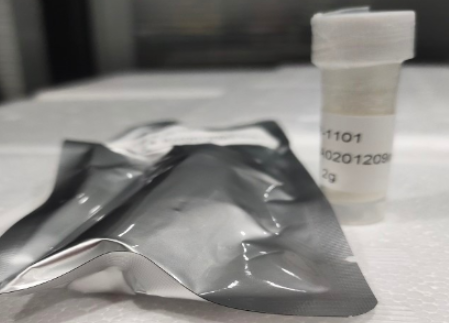文献:Preparation and Characterization of Folate-Targeted Fe3O4 Nanoparticle Codelivering Cisplatin and TFPI-2 Plasmid DNA for Nasopharyngeal Carcinoma Therapy
作者:Juan Zhang, Huanhuan Weng, Xiangwan Miao, Quanming Li, Siqi Wang, Huifen Xie, Tao Liu, Minqiang Xie
文献链接:https://onlinelibrary.wiley.com/doi/full/10.1155/2017/2849801
摘要:
The FA-PEG-PEI@SPION-CDDP was constructed with SPION-CDDP (core) and FA-PEG-PEI (shell). Numerous detached electropositive amino groups in the shell covered SPION-CDDP nanoparticles were able to electrostatically adsorb electronegative TFPI-2 pDNA. To explore the binding ability of FA-PEG-PEI@SPION-CDDP with TFPI-2 pDNA, gel electrophoresis was observed in Figure 3(a). It was found that with the increasing mass ratio of FA-PEG-PEI@SPION-CDDP/TFPI-2 {Figure 3(a)~B (1 : 4) → C (1 : 2) → D (1 : 1)}, more TFPI-2 was blocked in sample well. When the mass ratio was equal to or more than 2 (Figure 3(a)~E), TFPI-2 pDNA was restricted completely in the well, indicating entirely adsorption and encapsulation by FA-PEG-PEI@SPION-CDDP. As a result, the relative mass ratio was determined as 2 : 1 to synthesize the final complex. To investigate the protection of TFPI-2-loaded complex (FA-PEG-PEI@SPION-CDDP-TFPI-2) against DNase-I degrading, FA-PEG-PEI@SPION-CDDP was mixed with overdose TFPI-2, then various content of DNase-I was added to run electrophoresis. As shown in Figure 3(b), compared with TFPI-2 migration without DNase-I in Figure 3(a)~B, the more DNase-I was added, the more detached TFPI-2 was degraded with more fade band of TFPI-2 migration. When DNase-I was equal to or higher than 15 units, the detached TFPI-2 (Figure 3(b)~J, K) was entirely digested except for the sample well. This evidence shed light on the enzymatic hydrolysis of DNase-I in TFPI-2 pDNA and indicated that FA-PEG-PEI@SPION-CDDP is feasible in adsorbing TFPI-2 and protecting pDNA from degradation. Thus pDNA could avoid digestion by DNase in media or blood before reaching the targeted cells, leading to an efficient transfection in tumors.

这个FA-PEG-PEI@SPION-CDDP用SPION-CDDP(核心)和FA-PEG-PEI(外壳)构建。壳覆盖的SPION-CDDP纳米颗粒中的许多分离的正电氨基能够静电吸附电负性TFPI-2 pDNA。探索其结合能力FA-PEG-PEI@SPION-CDDP对于TFPI-2 pDNA,凝胶电泳。
发现随着质量比的增加FA-PEG-PEI@SPION-CDDP/TFPI-2{图3(a)~B(1:4)→C(1:2)→D(1:1)},更多的TFPI-2在样品孔中被阻断。当质量比等于或大于2时,TFPI-2 pDNA完全限制在孔中,表明完全被吸附和包封FA-PEG-PEI@SPION-CDDP.结果,相对质量比被确定为2 : 1 合成最终的复合物。
TFPI-2负载复合物的保护作用研究(FA-PEG-PEI@SPION-CDDP-TFPI-2)抗DNase-I降解,FA-PEG-PEI@SPION-CDDP与过量TFPI-2混合,然后加入不同含量的DNase-I进行电泳。
中没有DNase-I的TFPI-2迁移相比,添加的DNase-I越多,TFPI-2的降解程度越高,TFPI-1迁移的衰减带越多。当DNase-I等于或高于15个单位时,除样品孔外,分离的TFPI-2完全被消化。
这一证据揭示了TFPI-2 pDNA中DNase-I的酶水解,并表明FA-PEG-PEI@SPION-CDDP在吸附TFPI-2和保护pDNA免受降解方面是可行的。因此,pDNA可以避免在到达靶细胞之前被培养基或血液中的DNase消化,从而在肿瘤中实现高效转染。
相关推荐:
OH-PEG-SS
OH-PEG-SG
LA-PEG-OH
N-(3-hydroxypropyl) phthalimide-PEG-OH
Benzyl-PEG-OH
PLGA(20K)-PEG-OH
PCL(5K)-PEG-OH
PLA(2K)-PEG-OH
OH-PEG-PLA(3K)
6-NO2DA-PEG-OH
OH-PEG-AA
OH-PEG-SCM
以上文章内容来源各类期刊或文献,如有侵权请联系我们删除!




 齐岳微信公众号
齐岳微信公众号 官方微信
官方微信 库存查询
库存查询